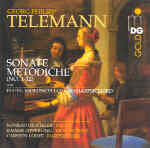Telemann wrote these sonatas to teach amateurs to play in the style of the virtuosi, specifically with respect to the practice of proper ornamentation. This recording of “methodical” sonatas–wherein Telemann actually wrote out the ornaments for the recapitulations of the slow movements that typically began the pieces–holds more interest (but not much more) as music than, say, a disc of examples from Quantz’s On Playing the Flute. As is the case with particularly fertile composers such as Telemann, not all of his compositions hold your attention; and given that Telemann wrote works purposefully for publication (more so than his contemporaries), these pieces, however masterfully crafted, come across as didactic and, well, “methodical”, and thus expose their commercial intentions.
Naturally, appealing moments abound in these works, which are nicely recorded in a kind of matte-background acoustic: the beautiful Grave of the G minor sonata; the sweet melody wafting in the Adagio of the A major; and a charming, even naïve tune in the Cunando movement of the E minor, to name a few. After a while, though, unless you are actually studying these pieces (and a fair number of flutists do), they fade into the wallpaper.
Konrad Hünteler, who plays an original 18th-century flute by Jacob Denner, a well-known maker of wind instruments at the time, manages his way through the cycle’s twists and turns but he doesn’t make it sound easy. His lower register (more a symptom of his vintage instrument than his skill, no doubt) at times sounds muddy, muted, and strained. This feature of his playing comes through mostly in the slower movements and in some of the more plodding sections, such as the Cortesemente in the A major sonata. His pronounced tendency to “overblow” through sustained notes results in a slight sharpening of the pitch. More impressive are the swifter movements, where you have to marvel at Hünteler’s command of this often-intractable instrument.
































